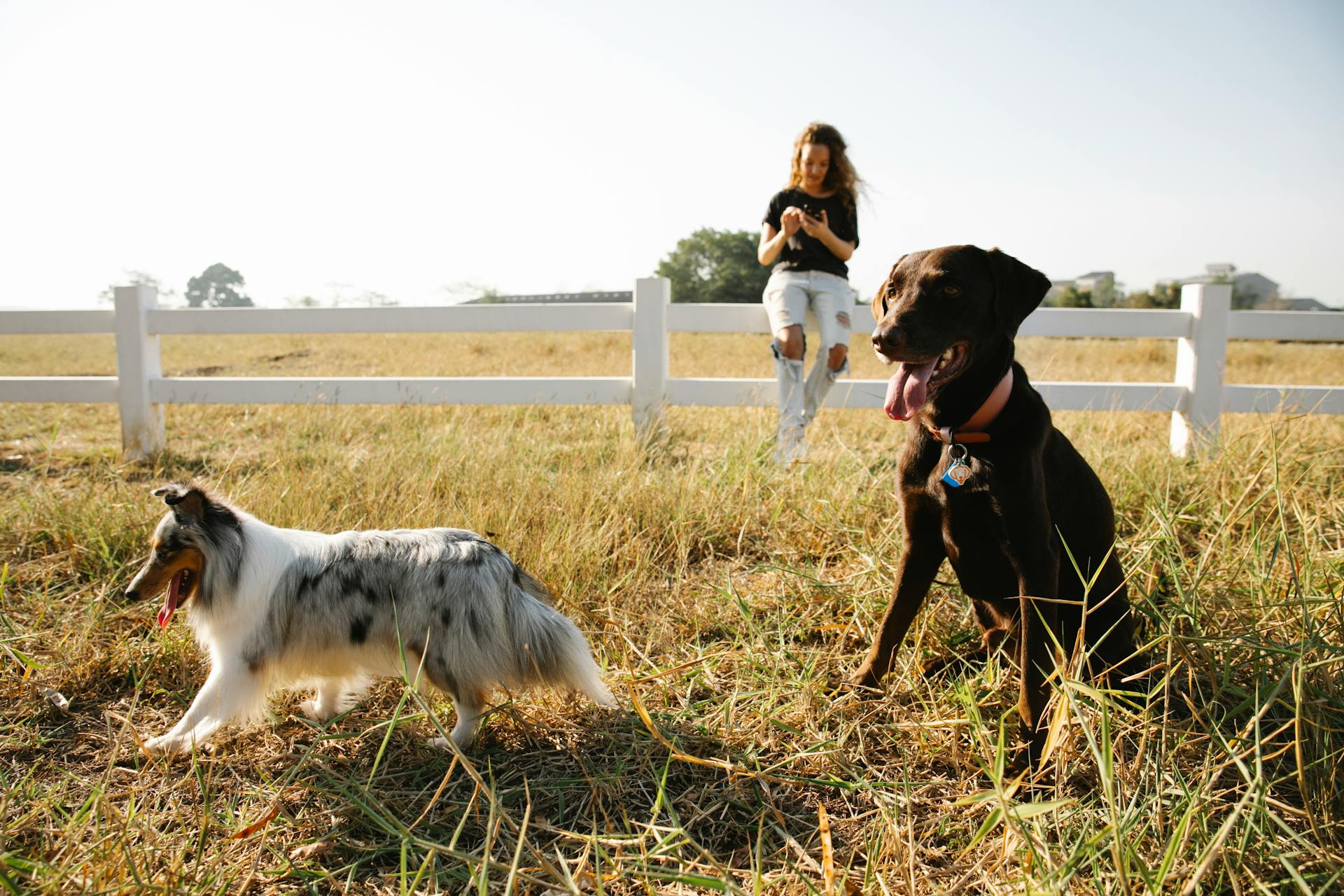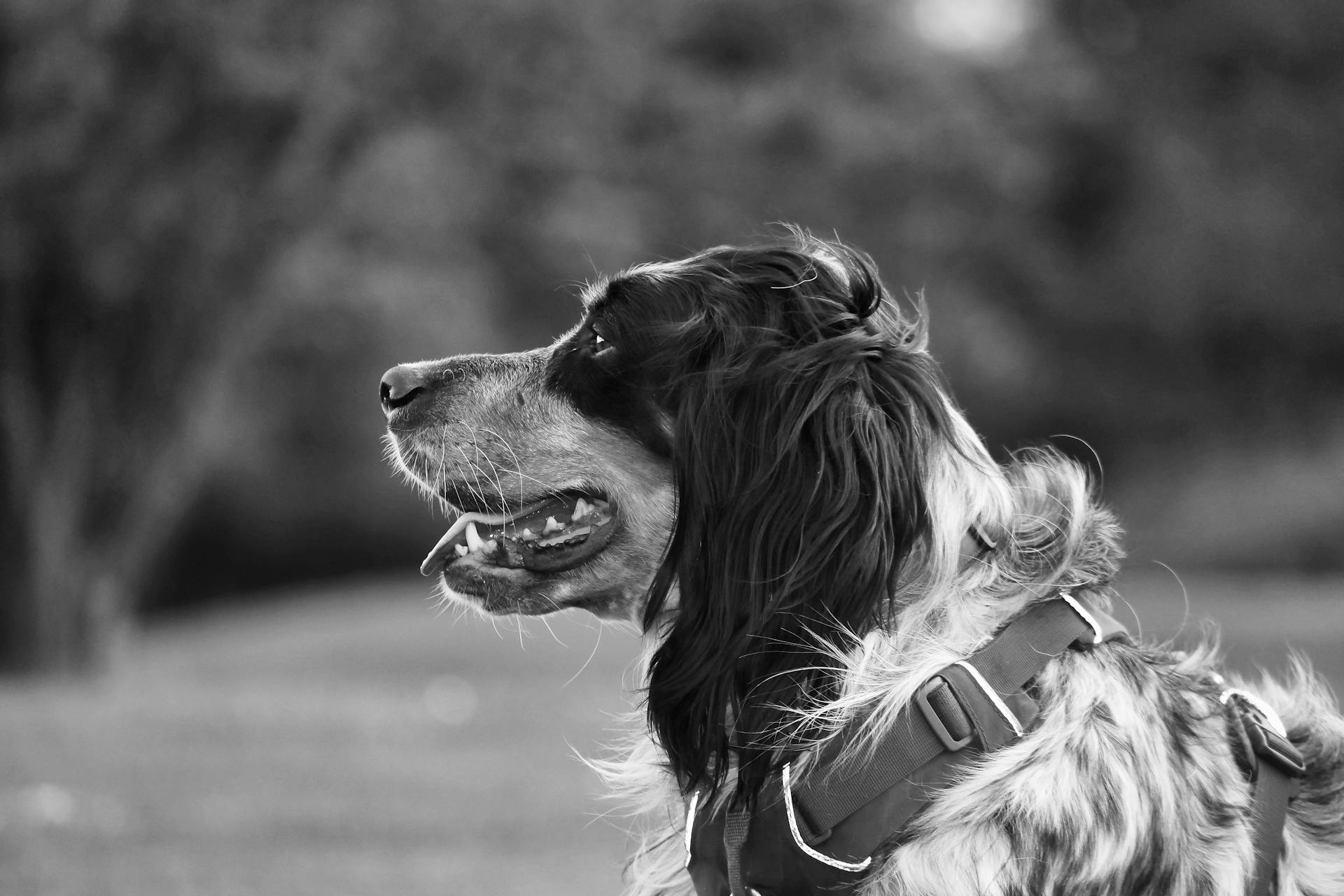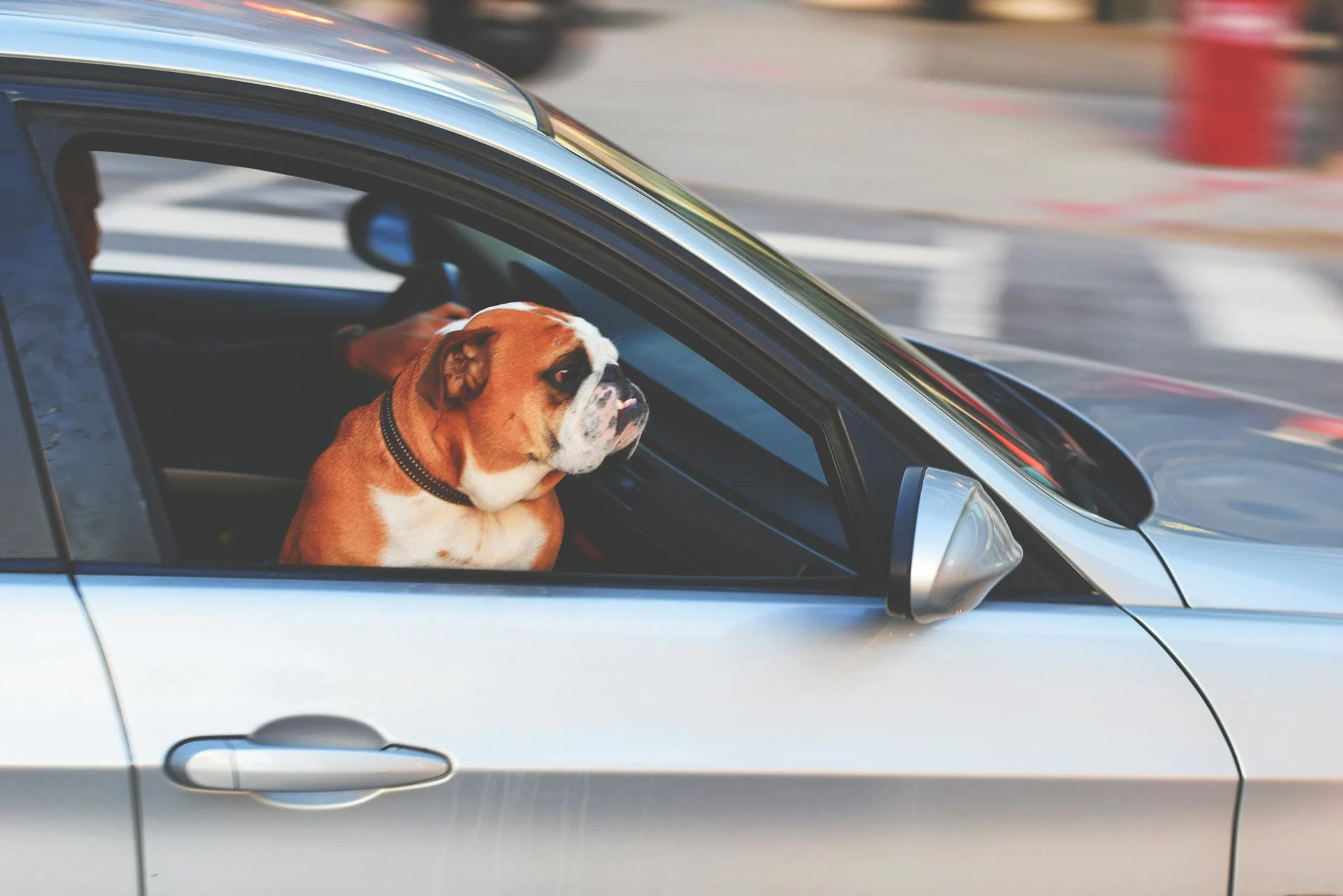
English Labradors are a popular breed known for their friendly, outgoing personalities. They were originally bred as waterfowl retrievers and have a strong instinct to please their owners.
English Labradors are relatively large dogs, with males weighing between 65-80 pounds and standing between 22.5-24.5 inches tall. They have a short, dense coat that requires regular grooming.
One of the key characteristics of English Labradors is their high energy level, which makes them well-suited for active families. They require at least 30 minutes of exercise per day to stay happy and healthy.
English Labradors are also highly intelligent and trainable, making them a popular choice for first-time dog owners.
History and Origins
The English Labrador's history is a fascinating story that spans centuries. They originated in 19th-century Newfoundland, where they were bred as working dogs to assist fishermen by retrieving nets and catching fish.
Their early development was influenced by European settlers, who imported these dogs to England in the 1830s. The breed quickly gained popularity among the nobility, who valued their temperament and retrieving abilities.
By the 1830s, the English Labrador's origins were already established in Newfoundland, where they were known as St. John's dogs. These dogs were highly valued for their working nature.
The first English Labradors were bred with British hunting dogs, leading to the creation of the breed we know today. Their early patrons included prominent figures such as the Earl of Malmesbury and the Duke of Buccleuch.
The breed was recognized by the Kennel Club in 1903, and by the American Kennel Club (AKC) in 1917. The first American AKC registration was in 1917.
Interestingly, the English Labrador was initially confused with the Newfoundland and the Lesser Newfoundland. However, Colonel Peter Hawker distinguished the Labrador from these breeds in his book Instructions to Young Sportsmen, published in 1846.
The English Labrador's popularity as a hunting and sporting breed grew over time, leading to the development of different color varieties, including liver and yellow. The first liver-colored Labrador was documented at the Buccleuch kennels in 1892, while the first yellow Labrador on record was born in 1899.
You might like: Akc Yellow Labrador
Physical Characteristics
English Labradors are known for their sturdy build, which is essential for their historical role as hunting and retrieving dogs. Their robust physique makes them excellent companions for various activities.
They typically weigh between 55 to 80 pounds, with males usually being heavier than females. A full-grown English Labrador usually weighs between 55 to 80 pounds.
Their height ranges from 21.5 to 24.5 inches, with a slightly stockier build compared to American Labradors. English Labs are athletic in appearance with a large head and medium-sized folded ears.
Their coat is short, dense, and water-resistant, which helps them thrive in colder environments. The undercoat provides insulation, allowing them to stay warm in cold weather.
The acceptable colors for English Labradors are black, yellow, and chocolate, with the shade of yellow varying from cream to fox-red. The coat sheds a lot, so regular grooming is necessary to maintain its health and minimize shedding.
Here are the ideal weights for English Labradors:
Their broad head and strong neck give them a regal appearance, making them a beloved breed among many dog enthusiasts.
Temperament and Behavior
English Labradors are known for their friendly and outgoing nature. They make excellent companions and family pets, interacting well with both people and other animals.
Their friendly demeanor towards other dogs and pets is a key trait, making them thrive in social environments and enjoy making new friends. Proper socialization from a young age can enhance their behavior around other animals.
Some key points about their social behavior include:
- They generally approach other animals without aggression.
- They enjoy sharing toys and participating in group activities.
- They are often eager to investigate and meet new animals.
English Labradors are known for being one of the most gentle dogs and one of the least-aggressive dogs. They are friendly, adaptable, and sociable, making them a popular breed.
Their calm, loyal, and eager-to-please nature makes them great companions for individuals and families alike. They are also highly intelligent, which makes training a breeze.
English Labradors are affectionate and love to be around people. They thrive on companionship and enjoy engaging in activities that challenge them mentally. Regular training can enhance their natural good behavior and foster a closer bond with their owners.
Their calm disposition makes them suitable for homes with children, and they interact softly, even with younger family members.
You might enjoy: When Do Labradors Calm down
Health and Care
Maintaining the health and care of an English Labrador involves understanding their specific needs.
English Labradors are prone to common health issues, including hip and elbow dysplasia, which can lead to arthritis.
Their love of food and sedentary behavior can also lead to obesity. Regular veterinary check-ups can help catch these conditions early.
A high-quality diet is essential for their well-being, with food containing real meat as the first ingredient, balanced fats, proteins, and carbohydrates.
For your interest: Labradors and Food
Health and Care
English Labradors are prone to specific health issues, so it's essential to be aware of them. Regular veterinary check-ups can help catch conditions like hip and elbow dysplasia, eye problems, and obesity early.
Labradors love food, but overeating can lead to obesity, which is a significant issue. Keeping an eye on their food intake and exercising them regularly can help prevent this.
Maintaining a healthy diet is crucial for English Labradors. Look for high-quality dog food with real meat as the first ingredient, and consider a daily feeding schedule to regulate their intake.
You might like: Good Food for Labradors

English Labradors can suffer from elbow dysplasia and hip dysplasia, which can result in pain and discomfort. Depending on the severity, this can be managed with medication and therapy, but surgery may be an option.
Regular vet checkups and keeping an eye on your dog can help catch any issues before they become untreatable.
Typical Lifespan
English Labradors typically live between 10 to 12 years.
With proper care, including a healthy diet and regular exercise, many can live longer, ensuring a fulfilling life for their owners.
English Labradors have an average life expectancy of between 10 and 12 years, making regular veterinary check-ups crucial to their health.
Living a long and healthy life requires a commitment to providing the best possible care, and with the right attention, many English Labradors can exceed their average lifespan.
Explore further: How Long Do Labrador Retrievers Usually Live
Exercise and Training
English Labradors are an energetic breed that requires significant exercise to maintain their health. Daily activity of at least 60 minutes is essential for preventing obesity and fostering mental stimulation.
You can include walks, fetch, or swimming in their daily routine, as many Labradors love swimming. Interactive play helps strengthen the bond between the dog and owner, and it's also a great way to satisfy their energetic nature.
To keep them engaged and prevent boredom, consider varying activities and introducing new ones regularly. This will help keep them mentally stimulated and prevent destructive behavior.
Regular exercise is also crucial for their physical health, and they love to play and interactive dog toys are a great way to keep them active.
Here's a rough guide to their exercise needs:
Successful training for an English Labrador begins with positive reinforcement. This breed responds best to praise, treats, and playtime as rewards. Regular short training sessions, approximately 5-10 minutes, help maintain their focus.
Clear and consistent cues are essential for effective communication, and consistency in response to behaviors helps reinforce what is expected.
Breeding and Genetics
Breeding and genetics play a crucial role in maintaining the desirable traits of English Labradors. Understanding genetic diversity is essential for ensuring their overall health and temperament.
Genetic diversity in English Labradors helps reduce the risk of hereditary diseases, which can affect the breed. Responsible breeders often conduct health screenings and genetic testing to identify potential risks.
Common health issues in English Labradors include hip dysplasia, elbow dysplasia, and certain eye conditions. Responsible breeding practices can help mitigate these risks.
Responsible breeders prioritize health testing, temperament assessment, and educating prospective puppy owners. They also maintain detailed records of their dogs' health and lineage to make informed breeding decisions.
Breeding pairs should undergo screening for common genetic disorders, including hip and elbow dysplasia, heart diseases, and eye conditions. This ensures that puppies are less likely to inherit these issues.
Ethical breeders adhere to guidelines set by kennel clubs and breed organizations. They focus on producing puppies that conform to breed standards while promoting excellent temperaments.
Genetic diversity can be challenging to maintain, especially when certain traits are favored. However, prioritizing health over appearance is essential for sustaining genetic variation and preventing inbreeding.
By understanding the importance of genetic diversity and responsible breeding practices, you can make informed decisions when selecting a breeder for your English Labrador.
Related reading: Labrador Dog Heat Cycle
Adoption and Ownership
Adopting an English Labrador is an excellent way to find a loving companion. Various organizations support dog adoption, including local shelters and breed-specific rescues.
Adoption fees generally cover vaccinations, spaying or neutering, and microchipping, making this a cost-effective choice for dog lovers. This can be a huge relief for those who want to bring a new furry friend home without breaking the bank.
English Labradors are exceptional family pets, suitable for family environments due to their friendly disposition and patience with children. They are affectionate and enjoy spending time with their loved ones, making them a great addition to any family.
Adoption Options
Adopting a dog can be a cost-effective choice, as adoption fees often cover vaccinations, spaying or neutering, and microchipping.
Local shelters and breed-specific rescues support dog adoption, providing a wide range of dogs for potential owners to choose from.
Many shelters conduct behavioral assessments to match a dog's personality with the right family, making it easier to find the perfect companion.
Adopting an English Labrador from a reputable organization can be a great way to find a loving companion, as they often have dogs of varying ages and energy levels.
Adoption fees typically cover the initial medical care and identification of the adopted dog, making it a convenient option for dog lovers.
Lab Cost
Lab Cost can be a significant investment, ranging from $600 to $1,200.
You'll likely have no trouble finding a breeder due to the popularity of English Labs, but be cautious of irresponsible breeders and puppy mills.
Always ask for health clearances for both parent breeds from the breeder.
Seeing the puppies with their mother before buying is also a good idea.
If buying isn't an option for you, adopting is still a viable choice, especially since English Labs are also popular in shelters.
A fresh viewpoint: British Labradors Vs. American Labs
Family Compatibility
English Labradors are exceptional family pets due to their friendly disposition and patience with children.
They thrive in families where they can exercise a lot, so a large yard is a big plus.

Their loving nature makes them get along well with everyone in the house, including children.
However, it's worth noting that Labrador puppies can be very bouncy and have high energy, so they may not be the perfect pet for families with toddlers or small children who are unsteady on their feet.
Older, calmer Labradors can make the perfect family pet for people of all ages, as they are very sociable and love having someone around.
They also get along well with other animals, including dogs, cats, and rabbits, as long as socialization is done properly.
Grooming
English Labradors shed a lot, so regular grooming is essential to reduce shedding and keep their coat clean.
You'll need to brush their coat at least twice a week to remove loose hairs, but this may need to be increased to daily brushing during seasonal coat blow outs.
Checking their ears regularly for dirt and wax buildup is crucial to prevent infections.
Suggestion: English Mastiff Coat
It's best to bathe your English Labrador only when they need it, as their skin can be quite sensitive.
Their coat is short, stiff, and dense, making it weather resistant, but also prone to dirt and loose hairs.
Regular nail trimming is necessary to avoid overgrowth, and daily brushing of their teeth will help prevent dental decay or disease.
Their short coat requires brushing once a week to remove loose hairs and dirt, but more frequent brushing may be necessary during shedding seasons.
Their ears should be checked frequently to prevent infections, and regular bathing will help keep their coat clean and healthy.
You should also check their eyes often to ensure they're healthy and free from any problems.
Community and Resources
If you're an English Labrador owner, you're not alone in your passion for the breed. There are numerous clubs and online platforms available that provide support, resources, and opportunities to connect with others who share your enthusiasm.
These online communities offer a convenient way to connect globally, allowing you to share experiences, tips, and advice with others. You can find vibrant communities on Facebook groups, where owners share photos, stories, and health discussions.
Reddit forums are another great resource, where active discussions on training techniques and health advice can be found. Dedicated websites, such as the Labrador Retriever Club, also provide forums for members.
These online communities encourage engagement through Q&A formats, facilitating quick responses to common challenges. You can also find breed-specific articles and videos that enhance learning and community growth.
Here are some popular platforms to consider:
- Facebook groups: A great place to share photos and stories.
- Reddit forums: Active discussions on training techniques and health advice.
- Dedicated websites: Sites like Labrador Retriever Club provide forums for members.
Frequently Asked Questions
What is the difference between an English Labrador and an American Labrador?
American Labradors tend to be taller and more muscular, while English Labradors are stockier with a thicker tail. Understanding the physical differences between these two breeds can be a great starting point for learning more about their unique characteristics.
What is an English style labrador retriever?
English style labrador retrievers are a type of labrador bred for show, characterized by a distinctive blocky head, thick neck, and short legs. They originated in England as conformation dogs, differing from working labradors in their physical appearance.
Featured Images: pexels.com


